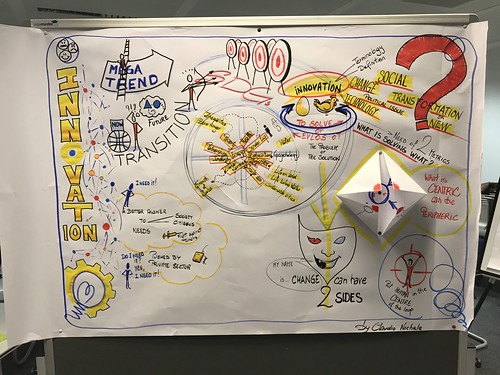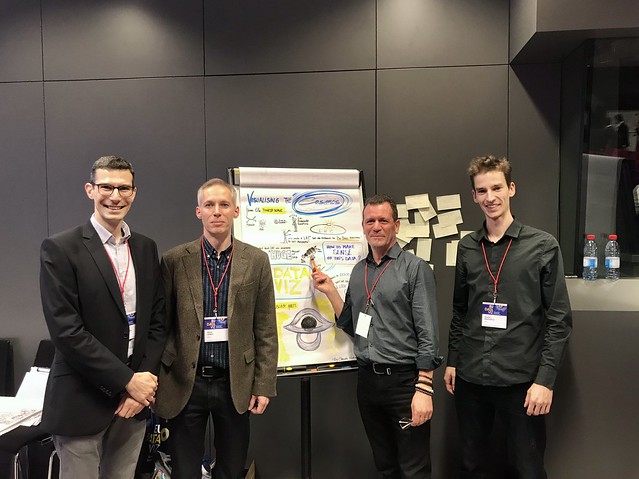In this post, I explain what is a visual thinker and the benefits of using the visual approach for individuals, groups and managers. Originally, it was a document that I shared with my superiors and colleagues to help them better understand. Then I thought that everyone could benefit from it.
Update (21 May 2024): If French isn’t a problem for you, then you might enjoy listening to this podcast where I try to answer some questions about visual thinking. What is sketchnoting, visual note taking? What benefits can this visual practice bring you in a professional environment or in your private life? What does this have to do with well-being and meditation? Where to start with sketchnoting?
What do I mean by visual thinker?

As a visual thinker, I use a visual approach mainly during live events to allow you and your participants to anchor information, find patterns, make your ideas visible, establish connections and relationships between your ideas, and to ultimately make sense out of chaos or complexity. It also activates the emotional intelligence of people, not just the rational one. It consists mainly of combining hand-made graphic elements with texts and visual metaphors. Different techniques allow me to meet different needs and obtain different results.
What are my visual techniques?

Graphic Facilitation and Graphic Co-creation
I use Graphic Facilitation and Graphic Co-creation as thinking tools for better discussions due to a different meeting setup. Both help people to find solutions, to innovate, to brainstorm, to reach consensus, to make decisions. Compared to the other techniques described below, the level of involvement of participants is high to very high in these two first techniques.
Example where researchers have had difficulty to agree on what is the meaning of “innovation”. Thanks to the visual elements they created with me on the paper they were able to “see” this difficulty. This awareness allowed them to redirect their discussion in a more constructive and clear way:
Example of using a hand-made visual template (also called canvas or harvesting sheet) to put participants in a different mental state and mood, conducive to better conversations and exchanges:
There is nothing better than #canvasses (#harvestingtemplates) to put your participants in another mental state conducive to better conversations and exchanges. pic.twitter.com/DS8lBaVdrE
— Claudio Nichele (@jihan65) September 21, 2019
Graphic Recording and Sketchnotes
I use Graphic Recording to visually capture live the main message of conferences, meetings, or training. This helps participants to “see” their thoughts, to consider the topic being presented and discussed from another angle, and to better retain information and learning. Depending on the circumstances, I work on a large mural or on flip-charts.
What better way to end the 1st #eudataviz day with the #graphicrecording of a fascinating session on how #dataviz helps us to better “see” black holes? Big thanks to Barthélémy von Haller and Jeremi Niedziela from @CERN and Oliver James from @dneg pic.twitter.com/EiUbGpsyBJ
— Claudio Nichele (@jihan65) November 12, 2019
The use of sketchnotes is quite similar to graphic recording in the sense that I also visually capture live what happens during an event. The difference lies in the paper size which is that of my notebook. Here participants don’t see my visuals directly (unless a camera projects my work on a big screen). I also use sketchnotes on many other occasions “just for me”, at work and at home. Whether it’s to organise my thoughts, to sketch a work planning or a process, for a to-do list or a grocery list, to plan my vacation, etc. Anyone can benefit from the practice of sketchnotes, and I guide those who wish during small learning sessions.

Visual communication
I use Visual Communication with hand-drawn illustrations to attract people’s attention incredibly. It gives more impact to your message, which is better understood and memorised by your audience. This is the technique with the lowest involvement level of the participants.
Example of visual communication with the story of the EC’s DG HR represented as a river. The handmade visual supported the Director-General’s speech and captured the attention of her audience.

Visuals as a Working tool
On a smaller scale, I use visuals in my daily routine as a working tool to offer more efficiency to my colleagues. It helps to clearly represent complex processes, workflows, etc; to capture, modelize and structure association of ideas, also for problem solving and project management.
What are the benefits of visual thinking?
I’m not going to review the benefits that neuroscience has long proven with hand-drawn visuals. I will simply mention the benefits that come from my direct and personal experience.
Benefits for an individual (at least for me)
- I grasp complexity better than reading a linear text
- It stimulates my imagination and creativity
- It helps me better retain information and learning
- I am more present and focused
- It’s a pathway to heightened my self-awareness, my understanding of others, and have a deeper connection with the world around me. It opens my mind to other perspectives
- It’s a source of well-being and a meditation channel
- I have more fun working on serious, tedious, complex topics
Benefits for a group or a team
- Visual thinking brings a new energy to the room that boosts collaboration and engagement (people realise this is not an ordinary event)
- The large format graphic helps participants to work together more
effectively because:
- they can “see” their ideas and what others are saying too
- everyone can contribute, feel heard
- the process and its progress is visible
- The large format graphic creates also a neutral space that encourages the debate about ideas while it reduces interpersonal conflicts
- It helps the participants stay focused on the discussion (less distracted)
- An individual can isolate himself from the group and think in front of the large format graphic
- It brings more clarity and less ambiguity
- It generates collective and emotional intelligence by unlocking collective creativity
- It improves collective understanding of concepts and sharing of agreements. The group can get on the same page
- It transcends language barriers, eases conflicts, and dispels misunderstandings
- It allows to achieve emotional and deeply relevant results
- The meeting report is created on the go.
- It will hold the participants accountable for what they have said and decided
- It will help them to remember and share their work with others
Benefits for managers and the organisation
- Visual thinking is a powerful and effective tool
- It gives the image of a modern and positive leadership
- It contributes to better decision making and better shared decision making, both achieved much more effectively
- It enables to tap into the collective, creative and emotional intelligences of a group in order to:
- Deal with complex issues
- Collect information to make informed decisions
- Meetings are with fewer interpersonal conflicts and more debate about ideas
- It leads to greater buy-in for visions, strategies, actions plans, decisions; to better commitment to these and better appropriation for a sustainable change
- It generates greater accountability for what is said and decided
- It denotes a transparent communication
- It materialises the recognition to individual contributions and group consensus
- It leads to more motivated teams
- It brings fun into otherwise boring jobs, tasks, and meetings
Do you love stories?
A real story of disruptive and unconventional thinking that I told in an interview that is worth reading:
Some years ago, Robert Madelin was appointed Director-General of DG INFSO and he requested major changes in the way the DG ran its intranet. To explain to him that we didn’t have enough time to apply all of them, given our available resources, I made our case to him with a quickly sketched story on paper, instead of a Powerpoint and Excel figures. Robert accepted our proposition because I was disruptive. I approached him with unconventional thinking. When I went to his office with a drawing, he said, ‘Oh my God, what is that?’ And when he looked closely, it helped him think differently about the problem. This for me was the opportunity to make my case and he accepted my explanation.
More examples
More examples of my work as visual thinker.
What others say about the benefits of visual thinking
- How does visual thinking help you at work?, Vision Factory
- 3 benefits of visual mapping in meetings, mindmappingsoftwareblog
- 10 benefits of doodling for creativity, productivity and focus, Canva
- The Cognitive Benefits of Doodling, The Atlantic
- Start Doodling in Class: The Value of Lo Fi Graphics in eLearning, Trakstar Learn
- The Benefits of Visual Note Taking in the Classroom, The Teaching Distillery
- Doodling should be encouraged in boring meetings, claims psychologist, The Guardian
- The Power of Doodling: How Doodles Can Lead to Great Ideas, Best Accredited Colleges
- Visual Thinking: Definition, Examples, and Tips, MindMaster
- The Benefits of Visual Thinking, IQ Doodle
- What Is Visual Thinking?, by Harappa
For even more resources, please see my collection of books and online resources.



























